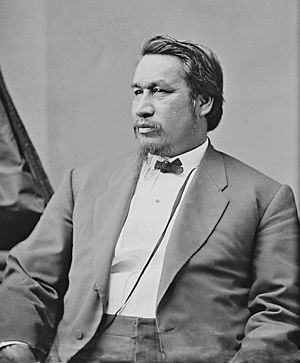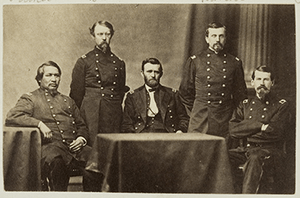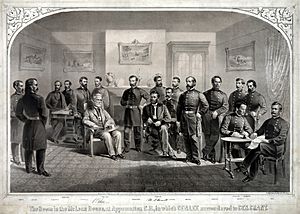Ely S. Parker facts for kids
Quick facts for kids
Ely S. Parker
|
|
|---|---|
 |
|
| Birth name | Ely Samuel Parker |
| Born | 1828 Indian Falls, New York |
| Died | August 31, 1895 (aged 66–67) Fairfield, Connecticut |
| Buried |
Forest Lawn Cemetery, Buffalo, New York
|
| Allegiance | United States |
| Service/ |
United States Army (Union Army) |
| Years of service | 1863–1869 |
| Rank | |
| Unit | Adjutant to General U.S. Grant 2nd U.S. Cavalry Regiment |
| Battles/wars | American Civil War |
| Commissioner of the Bureau of Indian Affairs | |
| In office 1869–1871 |
|
Ely Samuel Parker (1828 – August 31, 1895) was a very important person in American history. He was born Hasanoanda and later known as Donehogawa. He was a member of the Tonawanda Seneca nation.
Ely Parker was a U.S. Army officer, a lawyer, an engineer, and a tribal diplomat. During the American Civil War, he became a lieutenant colonel. He worked closely with General Ulysses S. Grant as his assistant and secretary.
Parker even wrote the final version of the surrender terms for the Confederate army at Appomattox. After the war, he became a brevet brigadier general. When Ulysses S. Grant became president, he chose Parker to be the Commissioner of Indian Affairs. This made Ely Parker the first Native American to hold such a high position in the U.S. government.
Contents
Early Life and Education
Ely Parker was born in 1828 in Indian Falls, New York. He was the sixth of seven children born to Elizabeth and William Parker. His birth name was Ha-sa-no-an-da, and he was later baptized Samuel Parker.
Both of his parents came from important Seneca families. His father was a miller and a Baptist minister. He was also a respected Tonawanda Seneca chief who fought for the United States in the War of 1812. His mother was the granddaughter of Sos-he-o-wa, a leader of the Haudenosaunee people.
Ely's parents believed strongly in education for all their children. Ely had a good education at a missionary school. He was bilingual, meaning he spoke both the Seneca language and English fluently. He later went to college. Throughout his life, he worked to connect his Seneca heritage with his life in the United States.
In the 1840s, when Ely was a teenager, his family's home became a meeting place. Many scholars interested in the Haudenosaunee people visited. These scholars included Lewis Henry Morgan, Henry Rowe Schoolcraft, and John Wesley Powell. Their studies helped create the field of anthropology, which is the study of human societies and cultures.
As a young man, Parker worked at a law firm. He studied law for three years, which was the usual way to become a lawyer back then. However, when he tried to take the bar examination to become a lawyer, he was not allowed. This was because, as a Seneca, he was not considered a United States citizen at that time. Most American Indians did not become U.S. citizens until the Indian Citizenship Act of 1924.
Ely Parker met the scholar Lewis Henry Morgan by chance in a bookstore. Morgan was a young lawyer who was interested in Native American culture. They became friends, and Parker invited Morgan to visit the Tonawanda reservation. Parker shared a lot of information about the Seneca and other Haudenosaunee nations with Morgan. Morgan later dedicated his book League of the Iroquois (1851) to Parker, saying they worked together on it.
This friendship helped both men. Parker helped Morgan become a pioneer in anthropology. Morgan helped Parker make connections in the wider American society. With Morgan's help, Parker was able to study engineering at Rensselaer Polytechnic Institute in Troy, New York. He worked as a civil engineer until the start of the American Civil War. Later, Parker was appointed to a very important job, Commissioner of Indian Affairs, a position Morgan had also been interested in.
Important Career Roles
Ely Parker started his public service career as an interpreter and diplomat. He helped the Seneca chiefs talk with the United States government about their land and treaty rights. In 1852, he was made a sachem (a chief) of the Seneca people. He was given the name Donehogawa, which means "Keeper of the Western Door of the Long House of the Iroquois."
As an engineer, Parker helped improve and maintain the Erie Canal. He also worked on other government projects. While supervising projects in Galena, Illinois, he became good friends with Ulysses S. Grant. This friendship would become very important later on.
Service in the Civil War
When the Civil War began, Parker tried to form a group of Iroquois volunteers to fight for the Union. However, the New York Governor turned him down. He then tried to join the Union Army as an engineer. But the Secretary of War told him he could not join because he was Native American.
Parker then contacted his friend, Ulysses S. Grant. Grant's army needed engineers. In May 1863, Parker was made a captain and joined Grant's forces. He became the chief engineer for the 7th Division during the siege of Vicksburg. His commander said Parker was a "good engineer."
When Ulysses S. Grant became the commander of the Military Division of the Mississippi, Parker became his assistant during the Chattanooga Campaign. He continued to serve Grant as his assistant at the U.S. Army headquarters. He was with Grant through the Overland Campaign and the Siege of Petersburg. At Petersburg, Parker was made Grant's military secretary with the rank of lieutenant colonel. He wrote many of Grant's important letters.
Ely Parker was present when Confederate General Robert E. Lee surrendered at Appomattox Courthouse in April 1865. He helped write the surrender documents, and they are in his own handwriting. Parker later shared a famous story about the surrender. He said that General Lee looked at him and then said, "I am glad to see one real American here." Parker replied, "We are all Americans." On April 9, 1865, Parker was promoted to brigadier general.
After the Civil War
After the Civil War, Parker continued his military service. He became an officer in the 2nd United States Cavalry in 1866. He again served as military secretary to Grant, who was then the commanding general of the U.S. Army. Parker was also part of a group that renegotiated treaties with Native American tribes. These tribes, mostly from the Southeast, had sided with the Confederacy during the war. Parker left the army in April 1869 as a brigadier general.
Family Life
In 1867, Parker married Minnie Orton Sackett. They had one daughter named Maud Theresa Parker.
Working for President Grant
Soon after Grant became president in March 1869, he appointed Parker as Commissioner of Indian Affairs. Parker held this important job from 1869 to 1871. He was the first Native American to ever hold this position.
Parker was a key person in President Grant's "Peace Policy" for Native Americans in the West. Under his leadership, there were fewer military actions against Native Americans. There was also an effort to help tribes move to reservations and adapt to new ways of life.
Later Work
After leaving government service, Parker invested in the stock market. At first, he did well, but he later lost his money after a financial crisis in 1873.
Through his social connections, Parker received a job with the New York Police Department. He worked on the Committee on Supplies and Repairs. Parker was often visited by Jacob Riis, a famous photographer who documented the lives of people living in poor areas. Riis even included Parker as a character in one of his short stories.
Later Life and Legacy
Ely Parker spent his last years in poverty. He died in Fairfield, Connecticut on August 31, 1895. He was first buried there. However, the Seneca people felt that his final resting place should be in their own territory. They asked his widow to move his body.
On January 20, 1897, his body was moved and reburied at Forest Lawn Cemetery in Buffalo, New York. He was laid to rest next to his ancestor Red Jacket, a famous Seneca orator, and other important people from Western New York.
Parker's life and his impact on Native Americans are discussed in the book Bury My Heart at Wounded Knee by Dee Brown. The town of Parker, Arizona is also said to have been named after him.
Images for kids
See also
 In Spanish: Ely Parker para niños
In Spanish: Ely Parker para niños






